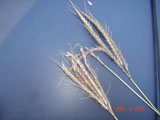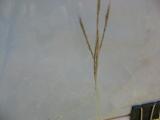Sign up for the iWire to get breaking news, event info and the species spotlight.
Go Back | Printer Friendly Fact Sheet
NOTE:
Dichanthium annulatum
Kleberg bluestem
Synonym(s): Andropogon annulatus, Andropogon nodosus
Family: Poaceae (Grass Family)
Duration and Habit: Perennial Grass/Grasslike

Photographer: Mary Jean Garcia
Source: Rio Grande Valley Invaders
Description
Kleberg bluestem grows as a bunchgrasses, with culms ranging from 8-40 inches in height. Leaf sheaths are 1.25 to 1.5 inches long, generally hairless, and leaf blades are 1.25 to 12 inches long and narrow in width. The inflorescence is comprised of a central stem with 2-15 racemes (flower branches) bearing numerous pairs of spikelets (flowers) along the central axis of the racemes. These grasses are characterized by a high density of reproductive shoots. Fast springtime growers and mature quickly
Native Lookalikes: Currently no information available here yet, or there are no native Texas species that could be confused with Kleberg bluestem.
Ecological Threat: When escaped from cultivation in pasture, can invade and outcompete native grasses in bluestem coastal prairie communities.
Biology & Spread: Prolific seed producers. They begin flowering in the spring, and seed in the summer. Seeds are readily transported by wind.
History:
U.S. Habitat: Thrive under grazing conditions and require full sunlight. Have low tolerance to acidic soils and high tolerance to drought and cold.
Distribution
U.S. Nativity: Introduced to U.S.
Native Origin: Africa, Asia, Papua New Guinea
U.S. Present: HI, LA, TX
Distribution in Texas: Kleberg's bluestem is only found in Texas and Louisiana.
Mapping
Invaders of Texas Map: Dichanthium annulatum
EDDMapS: Dichanthium annulatum
USDA Plants Texas County Map: Dichanthium annulatum
Invaders of Texas Observations
List All Observations of Dichanthium annulatum reported by Citizen Scientists
Native Alternatives
Big bluestem (Andropogon gerardii), Gulf muhly, gulfhairawn muhly (Muhlenbergia capillaris), Little bluestem (Schizachyrium scoparium)
Management
If the plant is less than two meters tall, hand pulling may be possible. Use a foliar or cut-culm treatment of 1.5% or 27 - 40% glyphosate, respectively.
USE PESTICIDES WISELY: ALWAYS READ THE ENTIRE PESTICIDE LABEL CAREFULLY, FOLLOW ALL MIXING AND APPLICATION INSTRUCTIONS AND WEAR ALL RECOMMENDED PERSONAL PROTECTIVE GEAR AND CLOTHING. CONTACT YOUR STATE DEPARTMENT OF AGRICULTURE FOR ANY ADDITIONAL PESTICIDE USE REQUIREMENTS, RESTRICTIONS OR RECOMMENDATIONS. MENTION OF PESTICIDE PRODUCTS ON THIS WEB SITE DOES NOT CONSTITUTE ENDORSEMENT OF ANY MATERIAL.Text References
The Quiet Invasion: A Guide to Invasive Plants of the Galveston Bay Area. Lisa Gonzalez and Jeff DallaRosa. Houston Advanced Research Center, 2006.
Online Resources
Search Online
Google Search: Dichanthium annulatum
Google Images: Dichanthium annulatum
NatureServe Explorer: Dichanthium annulatum
USDA Plants: Dichanthium annulatum
Invasive Plant Atlas of the United States: Dichanthium annulatum
Bugwood Network Images: Dichanthium annulatum











